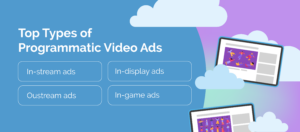In Lilach Bullock’s words, “Video marketing solidifies your online presence whilst building deep and meaningful relationships with your customers. It adds a personal touch to your brand whilst increasing your conversions!”
Video advertising has become an indispensable tool for marketers to connect with their target audience — 96% value it as an ‘important part’ of their marketing strategy. The visual and auditory appeal of video content and its ability to tell compelling stories make this medium a powerful choice for promoting products and services. However, the video advertising space has undergone some transformation with the introduction of programmatic video advertising.
The importance of programmatic video advertising cannot be overstated. In fact, it has become a vital component of the broader programmatic advertising ecosystem. According to Insider Intelligence, programmatic video ad spend is expected to grow 30% by 2025, signifying its increasing adoption among marketers. To understand the significance of programmatic video advertising, it’s essential to grasp its fundamentals.
What is Programmatic Video?
Programmatic video advertising is the automated process of buying and selling video ad space using programmatic technology. This means marketers leverage data and algorithms to determine the most effective ad placements and target specific audience segments. The result is an unmatched level of precision, efficiency, and effectiveness — the trifecta for succeeding in today’s fiercely competitive digital marketing landscape.
Put another way, programmatic video advertising uses technology to streamline the ad buying process. Instead of relying on traditional manual ad buying processes, this approach relies on automated auctions and real-time decision-making to ensure that ads reach the right viewers at the right time. This level of precision not only saves time and effort but also maximizes the impact of advertising campaigns as each viewer is exposed to the most relevant and engaging content.
How Does Programmatic Video Advertising Work?
The way programmatic video advertising operates is underpinned by the real-time bidding (RTB) process. This technique allows multiple advertisers to bid on ad inventory simultaneously. Publishers facilitate this by making their ad space accessible through supply-side platforms (SSPs), which, in turn, establish connections between the inventory, multiple ad exchanges, and demand-side platforms (DSPs). Here’s a breakdown of the process:
- User interaction: The process starts when a user visits a website or app with ad space.
- Request to SSP: The publisher’s site requests its SSP to fill the empty ad space.
- Evaluation by SSP: The SSP evaluates the user’s data, such as their demographics, interests, and browsing history, and then sends this information to the ad exchange.
- Connecting to the DSPs: Once the ad exchange gets the user’s data, it connects to the DSPs and relays the user’s data.
- Bid submission: DSPs analyze the ad request and submit real-time bids for the ad space.
Winner selection: The SSP selects the highest bidder from among the DSPs and serves their ad to the user.

Real-time bidding helps optimize publishers’ ad revenue by opening up their inventory to a broader range of potential buyers, thus increasing the opportunities for lucrative ad placements. The process is incredibly swift, taking place in mere milliseconds and ensuring that the user experiences minimal delay and disruption in their online activities.
Benefits of Programmatic Video Advertising
The rapid adoption of programmatic video advertising is driven by its numerous benefits to advertisers. Here are some of the top advantages that make this advertising approach a game-changer:
- Improved targeting accuracy: Programmatic video advertising allows for precise targeting of specific audience segments based on a wide array of data points. This granular level of targeting ensures that ads reach the most relevant viewers, increasing the likelihood of engagement and conversion.
- Efficiency and time-savings: Automating the ad buying process eliminates the need for manual negotiations and streamlines the workflow. Marketers can save time and effort while enjoying a more efficient means of reaching their audience.
- Transparency: Programmatic video advertising provides transparency in the ad placement process. Advertisers can monitor where their ads are displayed and ensure they align with their brand’s values and objectives.
- Support for multichannel advertising: Programmatic advertising doesn’t limit itself to a single platform. It extends its capabilities to various digital channels, allowing marketers to create holistic and consistent campaigns across different touchpoints.
- Data-driven optimization: The wealth of data available in programmatic advertising allows for continuous optimization of ad campaigns. Marketers can refine their targeting and ad creative based on real-time performance metrics, ensuring that each campaign improves over time.
- Quantitative reporting: Programmatic video advertising offers detailed reporting and analytics, allowing marketers to measure the effectiveness of their campaigns, make data-backed decisions, and refine their strategies.
- Cost-effectiveness: By reducing the inefficiencies associated with traditional ad buying methods, advertisers can allocate their budgets more efficiently and maximize the return on investment (ROI).
These benefits make programmatic video advertising a compelling choice for marketers looking to make the most of their advertising budgets while reaching a highly engaged and relevant audience.
Types of Programmatic Video Ads
Programmatic video advertising encompasses various ad formats that cater to different viewer preferences and contexts. Here are the main types of programmatic video ads:
In-Stream Video Ads
In-stream video ads are played within a video, and the two most common formats are linear and non-linear ads. Linear ads are like the standard TV commercial in that they take over the entire video player space. These ads appear:
- Pre-roll: The ads are shown before the beginning of the main video content. These provide a brief promotional message before the viewer’s intended content.
- Mid-roll: These ads appear within the main video content, temporarily interrupting the viewer’s experience.
- Post-roll: The ads are displayed at the end of the main video content. Post-roll ads ensure the viewer sees the promotional message after consuming the primary content.
Non-linear ads don’t pause the video. Instead, they run simultaneously with it. Non-linear ads typically occupy around 20% of the screen space, allowing the user to not watch the ad before accessing the desired content.
Outstream Video Ads
Outstream video ads appear within a web page or app, outside of a traditional video player. They autoplay when a user scrolls to them, ensuring they are less intrusive and more engaging for the viewer. Outstream ads can appear in a variety of formats, such as:
- In-article ads: These video ads appear within the body of an article or blog post.
- In-feed ads: The ads appear within a feed of content, such as a social media or news feed.
Native video ads: These ads are designed to blend in with the surrounding content. For example, a native video ad might appear as a sponsored post on a social media platform like YouTube.

In-Game Video Ads
In-game video ads appear within video games. They can be categorized into:
- Interactive ads: These ads engage players by allowing them to interact with the content, such as playing a mini-game or watching a short video for in-game rewards.
- Cross-page ads: The ads are displayed between levels or loading screens, ensuring that players remain engaged with relevant promotions.
- Rewarded video ads: In this format, players are offered in-game rewards, such as extra lives or virtual currency, in exchange for watching a video ad.
Each programmatic video ad format offers unique opportunities to engage with audiences in a way that aligns with the platform and context in which they are presented.
Programmatic Video Advertising Trends
As programmatic video advertising continues to grow, there are some emerging trends marketers need to be aware of:
The Rise of OTT and CTV Ads
Over-the-top (OTT) and connected TV (CTV) advertising are on the rise, driven by the increasing adoption of streaming platforms. As consumers shift from traditional television to digital streaming services, advertisers will increasingly leverage programmatic advertising to reach audiences on these platforms effectively.
Increasing Investment in Immersive Technology
The global immersive tech market size exceeded $26.53 billion in 2022 and is forecast to reach $134.18 billion by 2030. This market’s growth is extending to the marketing space, and the use of immersive technologies such as augmented reality (AR) and virtual reality (VR) in programmatic video advertising is growing.
Going forward, marketers will use these technologies to create engaging and interactive ad experiences that captivate viewers and drive brand engagement.
New Ad Formats
Advertisers are experimenting with new ad formats, including interactive video ads and shoppable video ads. Programmatic advertising will allow advertisers to use these formats more effectively by providing data-driven insights into their performance.
Contextual Targeting
As consumers become increasingly ad-blind, contextual targeting has gained prominence. Advertisers are focusing on aligning their ads with the content viewers are consuming, ensuring that ads are relevant and unobtrusive.
However, for marketers to reap the full benefits of contextual targeting, it’s crucial to create layered advertising strategies that include demographic and behavioral data on top of contextual data.
Integration into Multi-Channel Advertising
Programmatic video advertising is being integrated into broader multi-channel advertising strategies. This approach will ensure consistency and coherence across various digital touchpoints, enhancing the overall brand experience.
By combining the precision of programmatic advertising with the reach of multi-channel marketing, brands can significantly enhance the overall brand experience and drive greater success in the digital landscape.
The Growth of Programmatic AI

AI is already having a significant impact on programmatic video advertising, and its role will only grow in the future. Here are some of the ways that AI will likely shape the future of programmatic video advertising:
- Enhanced targeting: AI can refine targeting models by accounting for a broader range of factors, including contextual cues, behavioral data, and first-party data.
- Optimal ad delivery: AI can ensure real-time ad delivery to the right audience, reducing waste and boosting campaign performance.
- Transparent measurement: AI can be used to develop transparent and accurate measurement solutions for programmatic video ads.
- Creative ad formats: Marketers can leverage AI to create more compelling video ad campaigns, for example, personalized, interactive, and dynamic video ads.
- More effective campaigns: AI can help marketers create more effective video ad campaigns. For instance, they can test formats, target various audiences, and optimize campaign performance.
How to Start Using Programmatic Video Advertising
Programmatic video advertising has transformed the advertising landscape by providing marketers with a highly efficient, data-driven, and targeted approach to reaching their audience.
As video consumption continues to increase, programmatic video advertising is set to play an even more central role in the future of digital advertising. So it makes sense to make it a part of your broader marketing strategy. To do this, you need a well-thought-out plan and effective video ads. Here are some tips and best practices to help you get started on the right foot:
- Set specific goals and budgets: Define clear objectives for your campaigns. Whether it’s brand awareness, lead generation, or sales, having specific goals will guide your strategy. Additionally, allocate an appropriate budget to achieve these goals effectively.
- Target the right audience: Use the robust targeting capabilities of programmatic advertising to reach your ideal audience. Use data-driven insights to understand your audience’s demographics, behaviors, and preferences, ensuring your ads resonate with them.
- Choose the correct video ad formats: Select the video ad formats that align with your campaign goals and platform. Consider the context in which your ads will be displayed and choose formats that enhance the viewer experience.
- Track performance and optimize creatives: Constantly monitor the performance of your programmatic video campaigns. Collect, analyze, and interpret data effectively to identify trends and areas for improvement, and use these insights to optimize your ad creatives, ensuring they remain relevant and engaging.
For more in-depth guidance on how Grapeseed can uplevel your video advertising strategy, check out our Digital Video solution page.





